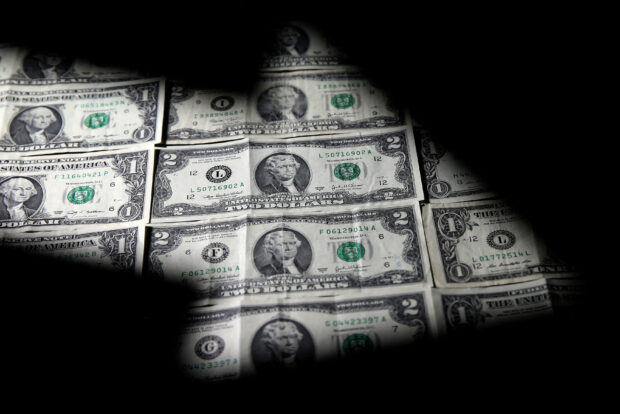Dollar banknotes. REUTERS/Dado Ruvic/Illustration/File photo
SINGAPORE – The U.S. dollar tumbled to a one-year low against a basket of currencies on Friday while the euro hit a one-year peak, as traders ramped up expectations of an imminent end to the U.S. Federal Reserve’s rate-hike cycle on signs of cooling inflation.
Data from the U.S. Labor Department on Thursday showed the producer price index (PPI) fell by the most in nearly three years last month, coming a day after inflation data pointed to moderation in consumer prices.
The greenback took another leg down on Friday and the U.S dollar index, which measures the currency against six major peers, tumbled to a roughly one-year low of 100.78.
It was last 0.15 percent lower at 100.82, and was headed for a weekly decline of more than 1 percent, its steepest since January.
Meanwhile, the euro rose to a fresh one-year top of $1.1075, pushing past Thursday’s previous high.
“The easiest way to express a dollar negative view has been with the euro,” said Ray Attrill, head of FX strategy at National Australia Bank.
“The significant downside surprise in U.S. PPI has made people a bit more convinced of the view that the Fed will (soon) be done … and (strengthened) conviction that inflation will allow the Fed to be cutting rates before the end of the year.”
Similarly, the British pound hit a 10-month high of $1.2545.
Money markets are pricing in a 69-percent chance the Fed will raise interest rates by 25 basis points next month, though a series of cuts are also being priced in from July through to the end of the year, with rates seen just above 4.3 percent in December.
Adding to signs that global inflationary pressure is waning was an unexpected surge in Chinese exports, which in March shot up 14.8 percent from the same month a year earlier, stunning economists who predicted a 7- percent fall in a Reuters poll.
The upbeat Chinese data, alongside a robust March employment report in Australia, kept the Australian dollar supported at around $0.6788 on Friday, having surged 1.3 percent in the previous session on the back of the data releases. The Australian and New Zealand dollars are often used as liquid proxies for China’s yuan.
“It was almost like a perfect positive storm for the Aussie,” said Attrill. “Starting with the employment numbers … and the China trade numbers which looked exceptionally good.
“You layer on top of that, the dollar weakness from the data last night and positive risk sentiment, and it was a (raft) of good news for the Aussie.”
The New Zealand dollar similarly gained 0.21 percent to $0.6310, after jumping 1.3 percent on Thursday.
Elsewhere in Asia, Japan’s yen rose more than 0.1% to 132.39 per dollar, while the offshore yuan gained 0.3 percent to 6.8495 per dollar.
Read Next
Subscribe to INQUIRER PLUS to get access to The Philippine Daily Inquirer & other 70+ titles, share up to 5 gadgets, listen to the news, download as early as 4am & share articles on social media. Call 896 6000.
For feedback, complaints, or inquiries, contact us.
For all the latest Business News Click Here
For the latest news and updates, follow us on Google News.

